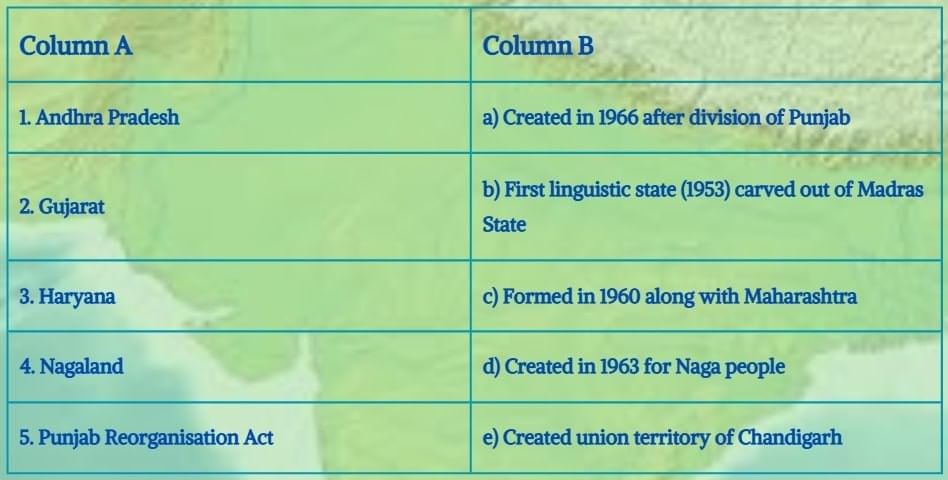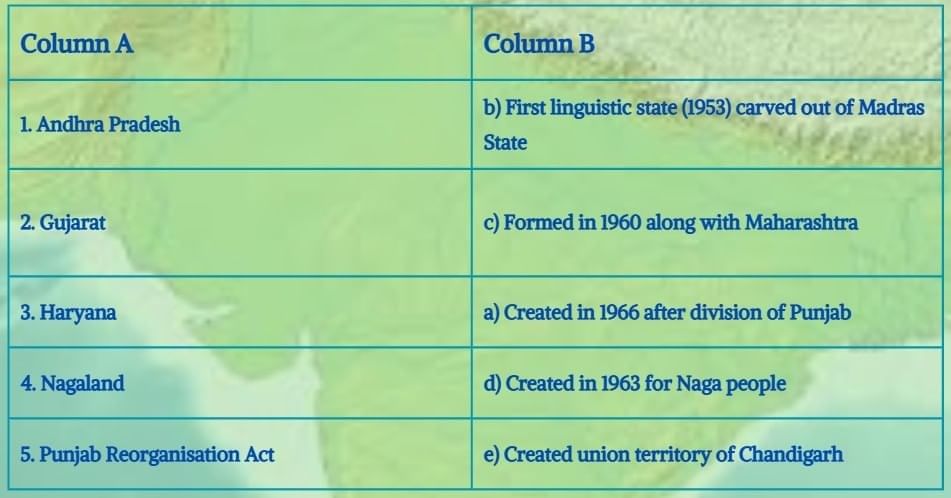Worksheet (Solutions): Reshaping India’s Political Map | Worksheets with Solutions for Class 8 PDF Download
| Table of contents |

|
| Multiple Choice Questions (MCQs) |

|
| Match the Following |

|
| True or False |

|
| Fill in the Blanks |

|
| Very Short Question Answers |

|
Multiple Choice Questions (MCQs)
Q1. The Delhi Sultanate was established in the year___________
(a) 1100 CE
(b) 1192 CE
(c) 1250 CE
(d) 1325 CE
Ans: (b) 1192 CE
The Delhi Sultanate was established in 1192 after the defeat of Prithviraj Chauhan.
Q2. Which dynasty did NOT belong to the Delhi Sultanate?
(a) Mamluks
(b) Khiljis
(c) Tughlaqs
(d) Gajapatis
Ans: (d) Gajapatis
The Gajapati kingdom was an independent kingdom in the east and not part of the Delhi Sultanate.
Representation of Delhi Sultanate
Q3. Who introduced the token currency in medieval India?
(a) Ala-ud-din Khilji
(b) Babur
(c) Muhammad bin Tughlaq
(d) Sher Shah Suri
Ans: (c) Muhammad bin Tughlaq
Muhammad bin Tughlaq introduced token currency with copper coins which caused economic confusion.
Q4. The Sun Temple at Konark was built by___________
(a) Krishnadevaraya
(b) Narasimhadeva I
(c) Rana Kumbha
(d) Malik Kafur
Ans: (b) Narasimhadeva I
He built the iconic Sun Temple to celebrate victories against the Sultanate.
Q5. The capital of the Vijayanagara Empire was___________
(a) Delhi
(b) Madurai
(c) Hampi
(d) Bijapur
Ans: (c) Hampi
Hampi was the capital and a major cultural center of the Vijayanagara Empire.
Q6. Who was the founder of the Mughal Empire in India?
(a) Akbar
(b) Babur
(c) Humayun
(d) Sher Shah Suri
Ans: (b) Babur
Babur founded the Mughal Empire after defeating Ibrahim Lodi in 1526.Babur
Q7. Which Mughal ruler is known for abolishing the jizya tax and promoting sulh-i-kul?
(a) Jahangir
(b) Akbar
(c) Shah Jahan
(d) Aurangzeb
Ans: (b) Akbar
Akbar abolished jizya and promoted religious tolerance through sulh-i-kul.Akbar
Q8. The Battle of Saraighat was fought between the Mughals and the___________
(a) Rajputs
(b) Sikhs
(c) Ahoms
(d) Hoysalas
Ans: (c) Ahoms
Ahoms defeated a larger Mughal force using river guerrilla tactics.
Q9. Which Sikh Guru founded the Khalsa in 1699?
(a) Guru Nanak
(b) Guru Tegh Bahadur
(c) Guru Gobind Singh
(d) Guru Arjan
Ans: (c) Guru Gobind Singh
He created the Khalsa to strengthen Sikh identity and resistance.Guru Gobind Singh
Q10. Babur’s memoirs are called___________
(a) Ain-i-Akbari
(b) Baburnama
(c) Akbarnama
(d) Tuzuk-i-Jahangiri
Ans: (b) Baburnama
Baburnama is Babur’s autobiography revealing his thoughts and life.
Match the Following

Ans:
True or False
Q1. The iqta system made administrative positions hereditary in the Delhi Sultanate.
Ans: False
Iqta positions were not hereditary but were granted by the Sultan.
Q2. Timur’s invasion left Delhi devastated in the late 14th century.
Ans: True
Timur’s invasion caused massive destruction and political chaos.
Q3. Krishnadevaraya was a great builder and patron of literature.
Ans: True
He supported arts and authored the Telugu epic Āmuktamālyada.
Q4. Akbar started the jizya tax on non-Muslims.
Ans: False
Akbar abolished the jizya tax during his reign.
Q5. Ahom warriors used their knowledge of terrain to defeat the Mughals at Saraighat.
Ans: True
They used guerrilla tactics and terrain familiarity.
Q6. Guru Gobind Singh introduced the Khalsa for strengthening Sikh identity.
Ans: True
The Khalsa was created in 1699 to unify Sikhs militarily and spiritually.
Fill in the Blanks
Q1. Prithviraj Chauhan was defeated in ________, establishing the Delhi Sultanate.
Ans: 1192 CE
Q2. The Vijayanagara Empire was founded by two brothers, ________ and ________.
Ans: Harihara and Bukka
Q3. The Rajput leader who resisted Akbar at the Battle of Haldighati was ________.
Ans: Maharana Pratap
Q4. Babur’s army used ________ and ________ in the First Battle of Panipat.
Ans: gunpowder and field artillery
Q5. Trade and ________ were economic strengths of medieval India.
Ans: agriculture
Q6. Temples served as centers of ________, learning, and culture.
Ans: economy
Q7. The Ahoms defeated the Mughals in the Battle of ________.
Ans: Saraighat
Very Short Question Answers
Q1. What is meant by “medieval period” in Indian history?
Ans: The period from 11th to 17th centuries marked by foreign invasions, new dynasties, and cultural blending.
Q2. Name any two dynasties of the Delhi Sultanate.
Ans: Mamluks (Slave dynasty) and Khiljis.
Q3. Who was Timur and what was the impact of his invasion?
Ans: A Turkic-Mongol conqueror whose 14th-century invasion devastated Delhi and caused political chaos.
Q4. Why did Muhammad bin Tughlaq shift his capital, and what happened as a result?
Ans: To control the empire better, but the forced relocation caused hardship and was later reversed.
Q5. Mention one reason for the decline of the Vijayanagara Empire.
Ans: Defeat at the Battle of Talikota in 1565 by a coalition of Deccan Sultanates.
Q6. What was the jizya tax?
Ans: A tax levied on non-Muslim subjects under some sultans and Mughal rulers.
Q7. Name the founder of the Bahmani Sultanate.
Ans: It was established by rebelling governors from the Delhi Sultanate, but leadership is associated with Ala-ud-Din Bahman Shah.
Q8. Who was Rani Durgavati and why is she remembered?
Ans: Queen of the Gond kingdom who bravely resisted Mughal invasions and became a symbol of resistance.
Q9. What was a hundi?
Ans: An ancient financial instrument for transferring money, similar to a written order of payment.
Q10. Mention one contribution of Akbar to literature and culture.
Ans: He promoted translations of Sanskrit texts into Persian and supported arts and scholars.
FAQs on Worksheet (Solutions): Reshaping India’s Political Map - Worksheets with Solutions for Class 8
| 1. What is meant by "reshaping India's political map"? |  |
| 2. What historical factors have influenced the changing political map of India? |  |
| 3. How does the creation of new states impact governance in India? |  |
| 4. What role do movements for statehood play in reshaping India's political landscape? |  |
| 5. Can you provide examples of recent changes in India's political map? |  |















